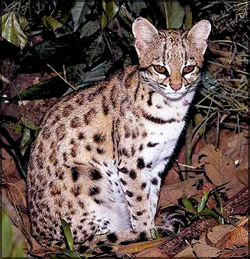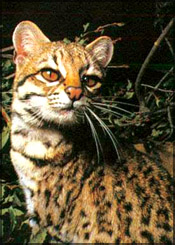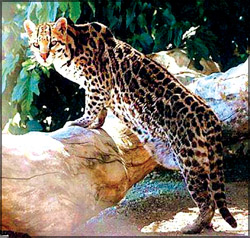 Felines: Felines:
Small, wild and beautiful
Elusive and shy by nature, the smaller members of the feline family
that are mostly nocturnal, are ideal for the creation of legends just
like the legendary unicorns.
Presently, around 37 species of wild cat have been identified and
most people (including you) may be familiar with the big five; the
tiger, lion, leopard, jaguar and cheetah.
About 30 species of small, wild cats are listed, but most of them
have not been studied in their natural habitats because they are hardly
seen. Lately though, much attention has been focused on these small
cats. Surprisingly, some of these small cats are large in size, like the
mountain lion, which is also known as a puma or cougar.
Even though there are differences of opinion about the classification
of certain species of the feline family in the group of small cats, such
classifications are not done merely by their size. Zoologists and
researchers take into consideration many other features such as their
ability to roar and purr and the appearance of their eyes and noses.
|

The Ocelot loves to rest on trees. |
|

Oncilla is petite in frame. |
The throat structure of the cats (big or small) enables them to roar
or purr. For example, if you have a pet cat, you will know how it
continuously purrs when being petted or is content.
Big cats however cannot purr continuously like your pet cat or other
'small' cats. They can purr only when they breathe out. Purring gets
interrupted when they breathe in; the sound gets distorted, coming out
more like a grunt or 'chuffle' as zoologists call it. On the other hand,
small cats cannot roar like the big cats.
This is because the bones in their throats are hardened and are close
together. This enables the small cats to produce only smaller vibrations
and so, the small cats can only mew, scream or growl, but, never roar.
Even though the power of the roar among big cats may be different,
their roaring, especially that of lions, could send a chill down the
spine of any person who happens to be anywhere near enough to hear it.
Going by this powerful roar, don't you think that only the cats which
really could roar should be classed as the 'big cats'? Now, let's check
out the other factors that differentiates the big cats from the small -
the eyes and noses.
|

Eyes are round and golden or brown in colour. |
You'll be surprised to learn that there are marked differences even
in these instances. Did you know that the eyes or pupils of small cats
closes to a vertical (up and down) slit while those of big cats closes
to a circular, like that of humans? May be you should observe your pet
cats more closely the next time you notice them reacting to light.
When it comes to the nose too there's a difference; some small cats
have a strip of leathery skin across the top of their noses, directly
above the wet tip, but in big cats, this particular area is covered with
fur.
Big or small, all members of the feline family are indeed fascinating
creatures, and today, we thought we'll introduce you to two of these
beauties. We hope to familiarise you with as many small wild cats as
possible.
There are small wild cats that are endemic to (only found in) our
country. The two cats we feature today are the Oncilla and the Ocelot.
More next week...
***
Fact file
* Small cats are found in habitats ranging from icy mountains to
steamy tropical jungles, to even scorching deserts.
* Like humans, cats have forward facing eyes, but cats can open their
pupils three times wider and see in the dark six times better than
people can.
* Without moving their heads, cats can detect movement within a
visual field of 280 degrees. That means they can see from the corner of
their eye a lot better than we do.
* Good hearing is important. Each ear is controlled by more than 20
muscles and the ears move independently of each other. Their ears can
quickly turn to catch sounds in all directions.
* Cats have very sensitive whiskers called vibrissae, on their lips,
cheeks, chins, eyebrows and forelegs that give them information about
their environment. The whiskers are deeply embedded in the skin and
connected to nerve endings that transmit information to the brain. A cat
can feel its way as it moves.
* Small cats are on the decline due to the fur trade and loss of
habitat.
* Some of the small wild cats are the pampas cat, bay cat,
black-footed cat, Andean mountain cat, fishing cat, sand cat, clouded
leopard, Canadian lynx, African golden cat, rusty spotted cat, bobcat,
leopard cat, marbled cat and Asian golden cat.
***
Oncilla
|

Coat is similar to a jaguar’s. |
The Oncilla (Leopardus tigrinus) is also known as the tiger cat,
little spotted cat, rigrina or tigrillo (Spanish). It is the smallest
Latin American cat with three sub-species described. It is closely
related to the Ocelot and the Marga. In French, it is called Oncilla and
in German, Onzille.
Found mostly in Costa Rica, South to northern Argentina, to northern
Peru, the Oncilla lives in Montane, clouded or humid lowerland forests
about 100 mts. in altitude.
It's slightly larger than the Asian flat-headed cat with a head/body
length of 40-55 cm, and a tail of 25-42 cm. It is 4-8 lbs. in weight,
the Oncilla has an exquisitely beautiful fur coat which is typically tan
to tawny in colour.
Symmetrical spotted patterns - brown spots fading to black blotches
are found throughout the length of the body including the feet. The
underparts of the body are almost white and less spotted. About 10-11
rings circle the black-tipped tail.
The spots are more or less in rows. The Oncilla's eyes are round with
golden to brown coloured irises. Though petite in frame, it is an
excellent hunter and an agile climber.
|

Sweet slumber. |
A solitary animal which is nocturnal, the males are territorial.
Females give birth to one or two kittens after a gestation period of
74-76 days.
Unlike the kittens of a domestic cat, the kittens of an Oncilla are
rather slow in development. They are born blind and would open their
eyes only after 17 days, that is about one week later than the kittens
of a domestic cat.
Oncilla kittens weigh 80-130 grammes at birth and take solid food
when they are 55 days old. The mother nurtures the kittens for 12 weeks.
The kittens stay with her until they are an year old. The diet of both
kittens and adults consists of small rodents, primates, birds, reptiles,
squirrels and insects.
The Oncilla's silhouette (dark shadow or outline against a lighter
background) and footprints closely resemble those of a domestic cats. It
also closely resembles the margay and so, it is rather hard to
differentiate the two species in the wild.
Very little is known about the present status of the Oncilla
population, but it is believed that they live 12-15 years in the wild.
The International Union for the Conservation of Nature and Natural
Resources (IUCN) and the Convention on International Trade and
Endangered Species (CITES) have listed Oncillas as 'vulnerable' and
trade of any kind is now banned.
***
Ocelot
Like the Oncilla, the Ocelot (Leopardus pardalis) is also small, but
striking. It is distributed over South and Central America, Mexico, and
also seen in areas as far as Texas and in Trinidad in the Caribbean.
About 10 subspecies have been recognised.
At one time, they were hunted nearly to extinction for their coats,
which are similar to a jaguar's and beautiful with chain-like blotches,
boarded with black and lighter coloured centres covering the entire
length of the body.
The ground colour of the body is tawny yellow through reddish or grey
with a whitish underside heavily marked with spots, rings, blotches and
short bars. The back of the ears are black with a central yellow spot.
The Ocelot is up to 100 cm (32 inches) in length, with a tail of 45
cm (16 inches). It weighs about 10-15 kg (20-33 lbs).
The Ocelot is a nocturnal creature and is very territorial. In fact,
the males are known to fight fiercely, sometimes to their death, in
territorial disputes.
As they are solitary animals, they hunt for their food alone. Their
prey include small animals such as reptiles, birds, rodents and some
domestic animals like tiny piglets and poultry. Squirell monkey
opossums, lesser anteaters and land tortoises are some of the larger
prey.
They have very keen vision, including night vision. However, they
hunt by smell, mostly following odour trails.
Ocelots generally rest on trees or thick foliage during the day. Even
though they are solitary animals, sometimes the females share their
'spot' or resting place with another female.
Ocelot kittens, which are rather similar to the domestic kittens, are
born blind after a gestation period of 70 days. They have a thin
covering of hair on their bodies. Usually there are 2-4 kittens in a
litter. The kittens are about 8.5 ounces in weight. They become
independent by one year.
Like many wild cats, Ocelots too are kept as pets, but as they are
highly strung and unpredictable, it's best to let them live in their
natural habitats which are very diverse and include rainforests, montane
forests, thick bush, semi deserts, and coastal marshy and river banks.
Even though their lifespan in the wild is short, not exceeding 10
years at times, in captivity they live longer, sometimes up to 20 years.
Facts and pix: Internet |
